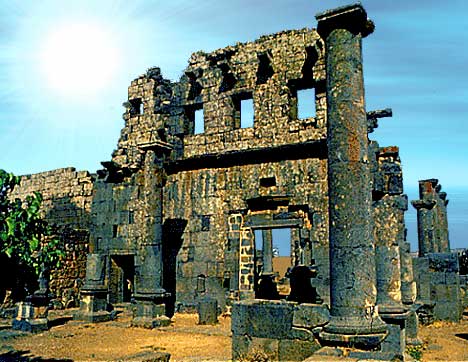About seven kilometers north east of al Swaida is the village of Qanawat situated, one of the most important historical places in Jabal al Arab.
In the first century BC, and before the rising of Bosra, Qanawat was the largest city in the region. It flourished because it was not far from one of the largest complexes of Nabatean temples of the city of Sei, just 4km south east.
Qanawat was well known during the Nabatean and, then, the Roman periods under the name of Qanatha and later Qanat.
It was one of the most famous commercial Deca Polises, a complex of several autonomous commercial cities.
At the end of the second century AD, Qanawat turned into an Arab province, and in the fourth and fifth centuries, it became the seat of a rich archbishopric.
The greatness and wealth of this city explain why its beautiful and attractive remains spread on a large area of the mound and on the slopes of the green valley around it.
Qanawat Antiquities:
At the entrance of Qanawat there is a road junction and a statue of a lion in prone position. If you proceed forward you will see, at 300m to the right, the exciting remains of the 2nd.
Century AD temple of Helios, God of the Sun, where there are seven Corinthian columns still standing from 27 columns that were here, a reference to the greatness of the construction of the temple outside the main wall of the city.
The temple is surrounded by a portico of many Corinthian columns some of them are still in the main square of the city. If we go back to the lion’s statue and turn right, we will go along a road lined with Roman and Byzantine fortifications.
It leads to an old tiled square, known as the Complex of Temples, located at the highest point in Qanawat and locally designated al Serai. This complex includes three temples that belong to the second century AD, and were later, in the fourth and fifth centuries, used by the Christian community.
Some of their main beautiful faÁades are well preserved with entrances surrounded by wheels carved with rich decorations inspired from ancient Greek and Roman buildings.
The internal courtyard connected two temples, together to form the shape of a straight angle. In the eastern part of the courtyard there is a subterranean prayer hall which was once used as a burial place. Here three stone sarcophaguses were discovered.
The main faÁade of the internal courtyard still has two gates of three, with the central one decorated with the most beautiful ornaments of Qanawat, protruding vine leaves spirally winding around each other.
At a distance of 100m south west of the Serai, there is another temple from the second century, the temple of Zeus, God of Heavens. This is confirmed by the writings on the walls and the six columns still standing with their Corinthian capitals among a grove of fruit trees.
The road near the Serai descends down to the valley of laurels, where, on the eastern side there is a small theater, or Odeon, 46m in diameter with nine tiers that can seat 2000 spectators. Most of the theater is dug in the rocks.
What we mentioned is not everything in Qanawat. When you visit the village, you will see many other antiquities.
You should have in mind also that Qanawat is not the only place in the region that has important monuments of great importance. At a distance of 3km south east of Qanawat, and on a plateau in “Sei”, which flourished in the first century BC, there are the remains of another Nabatean complex of temples.
The temple of Baal Shamin was the largest. Had not the Ottoman authorities dismantled its stones at the beginning of the 20th century, you would have seen one of the wonders of Nabatean ñ Roman architecture. But destiny intervened and saved a smaller temple that belongs to the first century.
Three kilometers west of Qanawat, and on the south eastern side of the village of Ateel, there is a Roman temple still preserving most of its structure, including a portico, Corinthian columns and the gate, still keeping its decorations.
Writings on the main column indicate that the temple was built in the 14th year of the rule of Emperor Antonios Bias, e.i.152AD.
Two kilometers north of Ateel, and on the left side of the road, stands the corner of a temple from the second or the third century AD. The remains of the temple show that it was larger and richer than the temple of Ateel. Proceed north bound to get to one of the most important cities in Jabal alArab, Shahba.
Haifaa Mafalani


 Home
Home